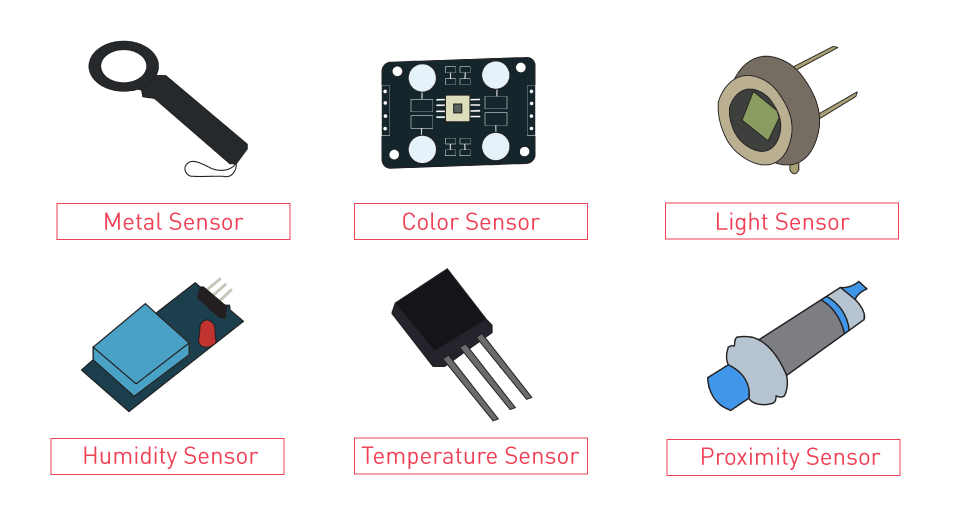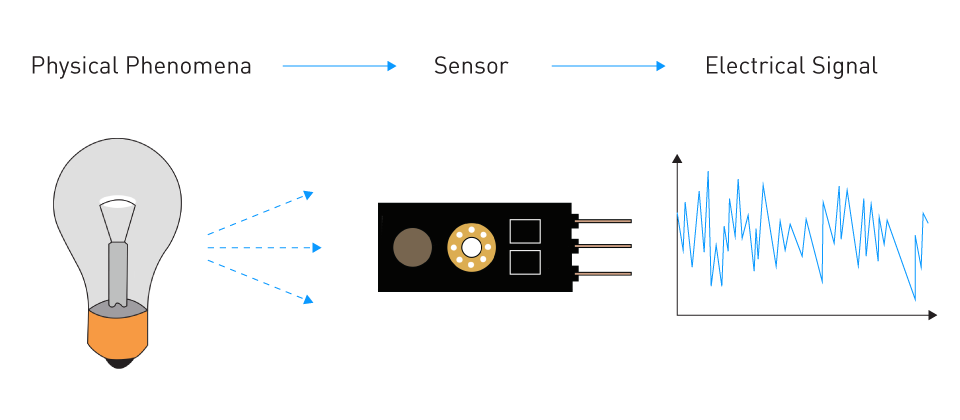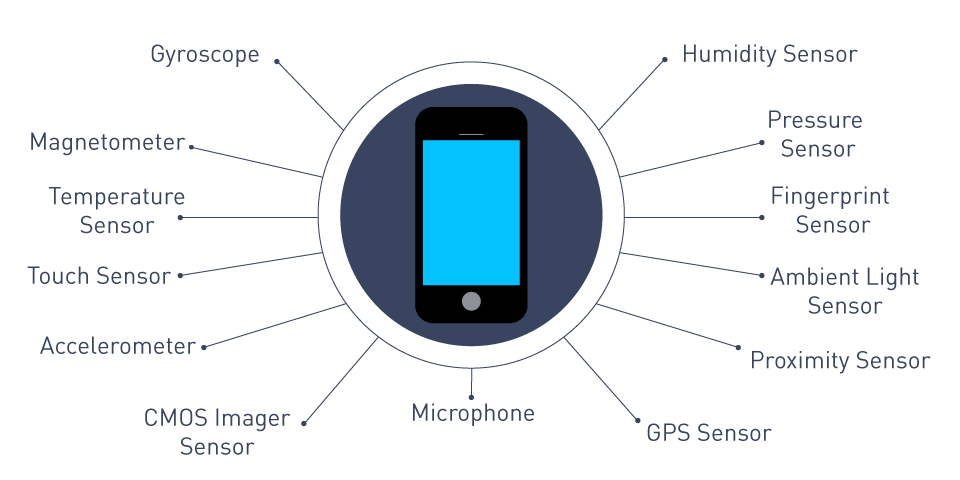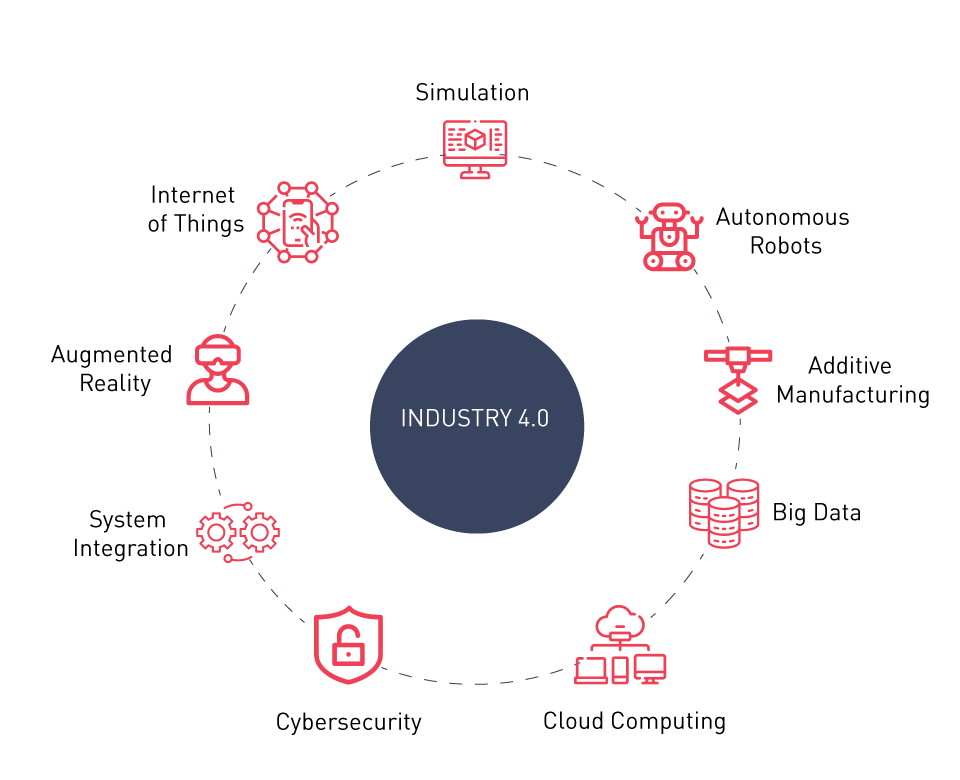In the field of engineering, sensors are crucial elements that are involved in the intricate interactions between the digital and physical domains. They serve as interpreters, converting a variety of physical occurrences into a language that electronic systems can comprehend, decipher, and use. Diving deeper into the world of sensors, it's critical to comprehend sensors' basic properties and how they differ from other components.

Figure 1: Types of Sensors
Definition and Basic Concept
Fundamentally, a sensor is an apparatus that recognizes occurrences or modifications in its surroundings and then generates a corresponding signal. Usually, this output is presented as an optical or electrical signal. But in order to start this process, there must be an initial input, which is often some kind of energy like heat, light, or mechanical force.

Figure 2: Sensors and Signals
Fundamental Role in Converting Physical Phenomena into Measurable Signals
Transforming one type of energy into another is one of a sensor's main functions. A temperature sensor, for example, transforms thermal energy, or heat, into an electrical signal. Since many systems, especially digital ones, can only interpret information in specified forms, this translation is essential. The capacity of sensors to close this gap is what makes them so beautiful. Through the conversion of physical events into quantifiable signals, sensors enable real-time monitoring, control, and optimization of our surroundings. These gadgets serve as the portal through which machines see the outside world, whether it is a smartphone's touch screen that recognizes input from the user or a barometer sensor that gauges air pressure.
Differences between a Sensor and a Transducer
Despite their frequent interchangeability, the terms "transducer" and "sensor" have some minor distinctions.
In a wider term, any device that transforms energy from one form to another is referred to as a transducer. Any kind of energy, including thermal, electrical, mechanical, and so on, may be converted in this way. As an example of a transducer, consider a loudspeaker that transforms electrical energy into sound energy.
A sensor, on the other hand, is a particular kind of transducer that is made to react to a certain stimulus and transform it into an optical or electrical output. An observer or gadget can then read this signal. Not all transducers are sensors, even if all sensors are transducers. For instance, the previously described loudspeaker is only a transducer, but a microphone—which transforms sound energy into electrical energy—is also a sensor.
In conclusion, a sensor is a specialized device created to detect and produce a signal in response to a certain stimuli. A transducer, on the other hand, is a general term for any apparatus that has the ability to change one type of energy into another.
Importance in Modern Technology
With its vast range of applications and quick progress, modern technology is almost entirely dependent on the capabilities provided by sensors. They play a crucial role in everyday life as well as in specialist domains, enabling a more connected, effective, and knowledgeable society.
The Omnipresence of Sensors in Daily Life: From Smartphones to Vehicles
One need only take a quick look at the gadgets surrounding them to understand the pervasiveness of sensors. Think about the smartphone, which is a useful tool for many people. Numerous sensors are included in even the most basic smartphone, including gyroscopes for rotation, accelerometers for detecting device orientation, proximity sensors, ambient light sensors, and more. Every single one of these sensors helps the gadget to function as a seamless interface between the environment and the user.

Figure 3: Smartphone Sensors
Moving beyond personal electronics, modern cars are examples of sensor-driven technology. Sensors in contemporary automobiles help with anything from parking to lane departure alerts. Sensors play a major role in advanced driving assistance systems (ADAS), which include functions including autonomous braking, adaptive cruise control, and blind-spot monitoring. These linkages open the door for the soon-to-be driverless car future while also improving driver safety and convenience.

Figure 4: Vehicle Sensors
Role in Industrial Automation and the Future of Smart Technology
Another perspective on the importance of sensors is provided by the industrial sector. Sensors play a major role in industrial automation, which is what propels higher production capacities and efficiency. These gadgets monitor, evaluate, and react to changes in production settings on a constant basis. Sensors are at the forefront of many applications, including maintaining exact temperature conditions in furnaces, spotting minute flaws on manufacturing lines, and streamlining warehousing operations.
In the future, the potential of Industry 4.0—also known as the Fourth Industrial Revolution, or 4IR, a phrase created to describe the current industrial transformation focused on automation and data—will only serve to increase the importance of sensors. They are essential elements in the development of "smart factories," where the collecting and analysis of real-time data results in previously unheard-of levels of optimization and flexibility.

Figure 5: Industry 4.0
Moreover, the future of smart technology is best summed up by the more expansive notion of the "Internet of Things" (IoT). IoT is powered by sensors, which are always gathering data. A refrigerator can tell you when to refill, a thermostat can learn your preferences, or a wearable may track your physical activity. These interconnected gadgets, which function as sensors' eyes and ears, are paving the way for a day when technology isn't simply intelligent—rather, it will be sensitive, instinctive, and pervasively present in our daily lives.
Sensors are more than simply parts of technology; they are the keystones that allow modern technology to evolve and become more capable, pushing the frontiers of industrial settings, personal devices, and planned future advances.
Sensor Functions
A sensor's functions include the core of its purpose. These functions act as the cornerstones for sensor use, operation, and design in a wide range of fields.
Detection, Transduction, and Generation of the Ouput Signal
Detection: A sensor's work begins with the detection of a certain physical occurrence. Any quantifiable quantity, such as temperature, pressure, light intensity, or chemical composition, might constitute the phenomena. The materials and architecture of the sensor are specifically designed to make it responsive to a certain kind of input. For example, a thermocouple senses temperature changes, but a photodiode is made to detect light.
Transduction: The sensor then transduces, or transforms, the physical characteristic it has observed into a different form—typically an electrical signal—after the detecting phase is over. The core function of a sensor is transduction. This is the point of transformation, converting a physical quantity into an interpretable, manipulable representation. For instance, mechanical pressure may be converted into an electrical voltage using a piezoelectric sensor.
Generation of Output Signal: Post-transduction, the transformed signal is seldom in a state that allows direct interface with other electrical devices or systems. Perhaps it's not in the proper format, too loud, or too faint. Conditioning this signal into a more useable form is hence the sensor's ultimate purpose. Amplification, noise reduction, and format modulation are some possible methods for doing this. Once conditioned, the output signal from the sensor can be used to drive additional processing, display, or decision-making in other electronic devices. For example, an output signal that triggers an alert or illuminates a light may be produced by an infrared sensor that detects human presence.
The sensor's purpose is essentially captured in the process from the detection of a physical parameter to the creation of a refined output signal. The foundation of sensor technology is this tripartite function, which guarantees its relevance and usefulness in a wide range of sectors and applications.




直接登录
创建新帐号